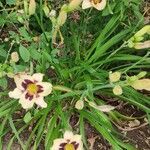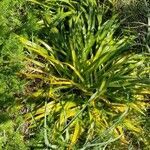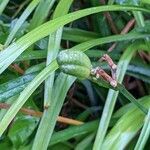Large, clump-forming, rhizome spreading. Leaves 40-70-(90) × 1-3 cm, linear, equitant, later drooping, margins smooth. Inflorescence corymbose, to 15-flowered; scape stiff, bracteate, usually branched. Flowers 8-10 cm long, to 9 cm diam., widely funnel-shaped (often doubled), dull orange-red, strongly veined, not scented; pedicels short; bract scarious, < pedicel; perianth-tube very short; lobes recurved, inner broader with undulate margins. Ovary and ovules aborted.












